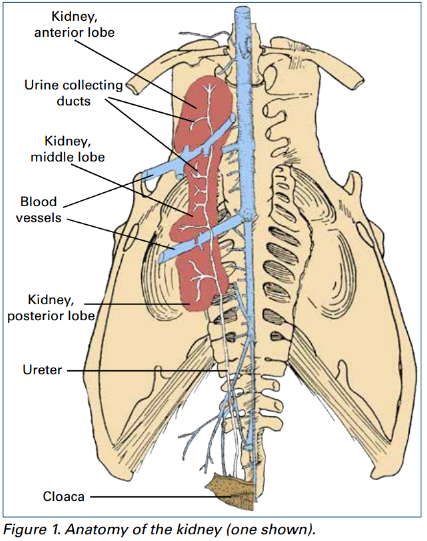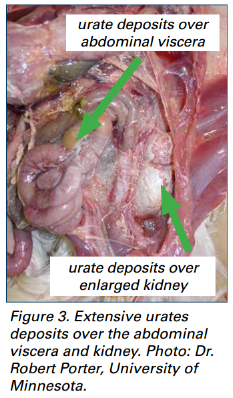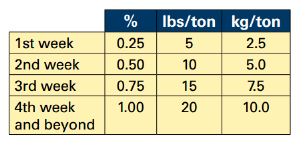



Avian Urolithiasis (Visceral Gout): An Overview
Visceral gout is a condition of chickens that has been recognised for more than 30 years. Due to its striking lesions, many names have been used to describe visceral gout, such as acute toxic nephritis, renal gout, kidney stones, nutritional gout, nephrosis and others.Introduction
Visceral gout is readily recognised by its distinctive lesions, which are characterised by white chalk-like deposits covering the surface of various abdominal organs as well as the heart sac.
Gout is a condition in which kidney function has decreased to the point where uric acid (nitrogenous waste) accumulates in the blood and body fluids. The uric acid subsequently precipitates as calcium sodium urate crystals in a variety of locations, particularly in the kidneys and on the serous membranes of the liver, heart, air sacs and joints.
The damaged kidneys are characterised by atrophied or missing portions of kidney lobes, kidney and ureter stones, and remaining kidney tissue that is swollen and white with urates.
Compensatory enlargement of remaining normal kidney tissue takes place in an attempt to maintain adequate renal function. Although gout has been recognised for some time as a cause of excessive pullet and layer mortality, it continues to be a diagnostic challenge.
Birds can be in full production and exhibit few external symptoms until shortly before death.
Chickens affected by renal damage can continue to be productive until less than one third of their normal kidney mass remains functional. Gout is not a single disease entity, but rather the result of kidney damage from any of a number of potential causes, which can be infectious, nutritional, toxic or possibly a combination of factors.
Kidney anatomy and function
The long, paired kidneys of the chicken are located in depressions in the pelvis bone in the abdominal cavity. They are normally reddish-brown in colour and have three distinct lobes or divisions.
The primary function of the kidney is to maintain the chemical composition of body fluids (blood). It serves a variety of other functions in the body: removal of metabolic waste and toxic products; conserving fluids and vital electrolytes; regulation of blood volume; and production of hormones that regulate blood pressure and production of red blood cells.
The kidney is truly a vital organ. When renal function stops, uric acid, normally excreted by the kidney in the urine, is then deposited any place that blood is circulated. A bird with no renal function will likely die within 36 hours.
Causes of gout
The cause of gout is often difficult to determine. The original kidney damage may occur long before the onset of gout mortality. Possible factors that can cause or contribute to gout are nutritional, infectious, toxic and others.
Nutritional causes
Nutritional or metabolic factors known to affect the kidneys are:
- Excess dietary calcium fed to immature pullets over a period of time will result in kidney damage that may lead to gout. This could result from a feed milling error, accidental delivery of layer feed to a rearing house, or excessively early use of pre-lay feed.
- Rearing diets that contain limestone in particle form may allow individuals to selectively pick out these particles, which would result in excessive intake of calcium. To ensure uniform intake, rearing diets should contain limestone only in a fine powder form. Particle-size limestone may be used beginning with the pre-lay diet.
- Phosphorus has been shown to partially protect the kidney against calciuminduced damage. Phosphorus acts as a urinary acidifier and helps prevent stones from forming in the kidney. Marginally low available phosphorus in rearing diets has been associated with higher gout incidence.
- Sodium bicarbonate is sometimes used to improve egg shell quality or combat the effects of heat stress. Sodium bicarbonate can contribute to gout by making the urine more alkaline, which, with high levels of calcium, is an ideal medium for the formation of kidney stones.
- Water deprivation, due to mechanical malfunction, may affect kidney function, but research has not demonstrated a direct result in gout.
- Vitamin A deficiency over a long period of time can cause damage to the lining of the ureters, but should be rare with modern vitamin formation.
- Extreme excess of dietary protein (30–40 per cent) can produce gout in experimental birds.
Infectious causes
Viral agents known to be involved in gout are infectious bronchitis and avian nephritis virus.
.PNG)
One mechanism by which bronchitis may affect the kidneys is chronic viral persistence, leading to nephritis and renal failure over time. As young birds are most susceptible to bronchitis kidney damage, the initial infection may occur long before renal function is critically reduced and mortality occurs.
When pullets sexually mature, they are placed on higher-calcium diets to meet the demands of egg production. If the kidneys were previously damaged, they may no longer function normally with the higher level of calcium excretion, and the result is likely to be gout.
Avian nephritis virus (ANV), an enterovirus that affects the kidneys, has been associated with kidney disease and serious outbreaks of mortality in Europe and Asia. Serological surveys show that antibodies to ANV can be detected in chicken and turkey sera around the world.
Although most information at this time suggests only a subclinical role for ANV, research has shown ANV inoculated into healthy chickens will cause inflammation of the kidneys and could lead to gout.
Toxins
Poisonous substances (toxins), while widely distributed in nature, are not considered major causes of production loss or disease in poultry in most countries. There are, however, problems that can arise from nephrotoxic substances.
Some potentially toxic substances are used on a routine basis, while others are the result of accidental exposure. Products used on a routine basis that have potential for human error and resulting toxicity are antibiotics, anticoccidials, minerals, vitamins, manufactured chemicals and pesticides.
- Antibiotics, such as sulfas and aminoglycosides, are eliminated from the body via the kidneys and are potentially nephrotoxic, particularly when water intake is restricted.
- Minerals and vitamins such as calcium, phosphorus, sodium and vitamin D3 are potentially toxic to chickens. Chicks, however, are much more sensitive to toxicity, probably because their kidneys are not fully developed.
- Disinfectants and insecticides, when used according to manufacturers' recommendations, are safe and effective, but a miscalculation of dosage can result in toxicity.
- Feeds contaminated by mycotoxins and phytotoxins (plant toxins) may also result in toxicity. Citrinin, ochratoxin and oosporein are mycotoxins that are nephrotoxic. Although these toxins will cause alterations in kidney function, they may not necessarily lead to gout.
Control
Gout, when recognised as a problem in field cases, is likely to be a multi-factorial problem, and identifying a specific cause is often difficult. Another reason for diagnostic difficulty is that kidney damage occurring during the growing period often has no apparent signs until the birds later come into egg production and are fed highcalcium diets.
Field cases and research have demonstrated the importance of interactions between two or more contributing factors, especially nutrition and infectious bronchitis.
Some preventive areas concerning nutrition are:
- Feed pullets no more than 1 per cent calcium in powdered form up to 16 weeks of age. High calcium intake in immature pullets can cause serious kidney damage.
- Available phosphorus levels should be 0.45– 0.50 per cent in rearing diets. Insufficient phosphorus predisposes the kidneys to calcium damage.
- Pre-lay ration should not be used before 16 weeks of age, or when the flock shows signs of sexual maturity (blooming of the combs). A calcium content of 2.50–2.75 per cent should be sufficient.
- If sodium bicarbonate is used to improve egg shell quality, use the minimum recommended level and only when needed. A flock with gout should not be medicated with sodium bicarbonate or fed a ration that is highly alkaline (high levels of sodium or potassium).
- Review all calcium and phosphorus levels in the feeding program. Pullet and layer feeds should be routinely analysed for calcium and phosphorus.
- Feed samples could be assayed for the presence of the mycotoxins citrinin, ochratoxin and oosporein.
- Water deprivation should be avoided in rearing and laying flocks.
Bronchitis alone has not been shown to trigger gout in research conditions, but in the presence of calcium-induced kidney damage, bronchitis does greatly amplify gout mortality. Due to the possible role of IB, the following should be considered.
- IB vaccines should be administered according to the manufacturers' directions and recommendations. To provide optimum protection, the vaccination program should include several live vaccinations of bronchitis (can be in combination with Newcastle) at about three weeks, eight weeks and 14 weeks of age by spray or drinking water. The degree of reactivity of the vaccinations starts low and is gradually increased each succeeding time, by using either a less attenuated virus or by giving it by a more reactive method, such as spray instead of water. Killed vaccines or live boosters throughout lay help keep bronchitis immunity high.
- The vaccine strains used should be those known to be endemic in the area. Use of several serotypes of bronchitis vaccine will generally improve cross-protection against other field variants and possibly against nephropathogenic strains.
- Due to the complex clinical signs associated with IB, a diagnostic laboratory should be enlisted to help in diagnosis and in virus isolation. Routine serological testing can provide initial indications of bronchitis challenges. Virus isolation may be facilitated with the use of SPF sentinel birds placed in the house and isolation attempts from them after 5–10 days of exposure.
Treatment
When gout mortality is recognised, the underlying kidney damage cannot be corrected, but treatment may help some birds live with marginal kidney function.
Current techniques for reducing gout mortality in pullets and layers rely on acidifying the urine to keep kidney stones dissolved and preserve functional renal mass of affected birds.
Ammonium chloride, ammonium sulfate, DLmethionine and methionine hydroxy analogue (Alimet) can all successfully acidify the urine. Check local regulations concerning the use of these compounds.
For flocks experiencing gout mortality, ammonium sulfate or ammonium chloride are recommended as shown in the table below. Wet droppings may be a side effect of ammonium chloride usage, but not with ammonium sulfate.
After 4–6 weeks of the maximum treatment level, if the desired results have been obtained, gradual reductions may be made. However, some level of treatment (around 0.5 per cent) will likely be needed for the flock's life. Both DL-methionine and Alimet can be used at up to 6 kg/ton (12 lbs/ton) of the diet.
Summary
The presence of gout mortality in pullets or layers indicates some form of kidney damage has occurred at an earlier time in the flock's life. Research supports a strong link for bronchitis and calcium/phosphorus imbalance as major causes of gout mortality.
While this is likely to be the underlying cause for most cases of gout, other factors, such as electrolyte balance, mycotoxins and water deprivation, need to be recognised as possible contributing factors. Likewise, any diet that increases urine alkalinity in combination with high calcium can contribute to gout mortality in pullets and layers.
If gout does occur in a flock, mortality can be reduced by increasing the acidity of the urine to dissolve existing kidney stones or to prevent additional kidney stones from forming.















